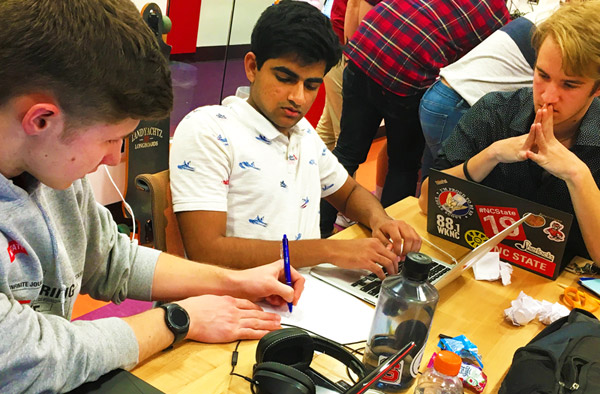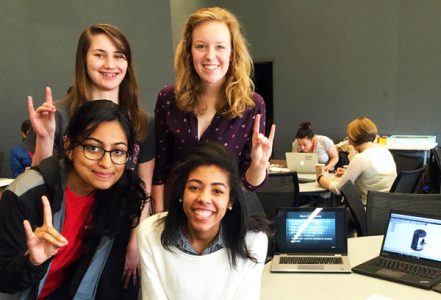Students design sustainability solutions in Make-A-Thon

By the time your shower has warmed you on cold days, cooled you on hot days, helped you wake up on early days or relax after a long days, you may not know how long you showered or how much water you used. But what if you could budget your water use like you budget your finances?
That’s the idea behind KnowURShower, designed by NC State students Brian Iezzi, Michael Meli, Bryan Murphy and Derek Whatley to reduce water and energy use associated with long showers.
In the prototype for this efficiency innovation, “the amount of LEDs [lights] that are turned on tell you how much water you have left in the water budget for that particular shower,” Whatley explained. “A companion app allows us to see a history of how much water we have used and how efficient our showers have been.”

KnowURShower earned the grand prize in NC State’s first Make-a-thon, a 45-hour challenge to create solutions to campus sustainability challenges. The Feb. 19-21 event brought together 42 students on 11 teams to compete in one of three categories: energy, waste or water. Armed with actual campus utility, waste and recycling data, student teams researched, designed and prototyped sustainability innovations.
“All we needed was a problem,” said Nic Leone, whose team designed the Step-Up Trash Compactor that maximizes capacity of campus waste and recycling bins. “Make-a-thon helped us think about a problem, and we were able to make this and could go patent it.”
With support of sponsors Autodesk, Glen Raven Inc., University Housing and Sparkfun, Make-a-thon was organized by NCSU Libraries, University Sustainability Office and four University Housing living and learning villages: Engineering Village, Women in Science and Engineering, EcoVillage and Albright Entrepreneurs Village.
A variation of a hack-a-thon with a sustainability twist, Make-a-thon kicked off with local entrepreneur and product designer Aly Khalifa challenging students to think big.
“He’s so inspiring and then we could go do something about it right away,” said textile engineering student Olivia Vanistendael, whose team designed a reusable coffee cup that collapses to easily fit in student backpacks. “This isn’t something I’d normally do. Make-a-thon was a fun way to pursue my interests and get ideas out there.”

After a busy first night of research and ideation, many teams spent the second day turning bright ideas into action. As the sun lowered Saturday evening, the Makerspace inside D.H. Hill Library buzzed bright with two dozen students crowded around laptops and 3-D printers.
“Does anyone know how I can animate this model?” asked one student.
“Yes! Look, it worked!” exclaimed another student as circuit board lights flashed in success.
While some students calculated paybacks to solar energy installations at residence halls, others built apps to encourage sustainable behavior or planned water recovery systems. With on-site software instruction and support from Autodesk and Glen Raven, many students took the design process to the next level by using 3D product design software Fusion 360 for prototypes.
“I like making things and this was hands-on experience in the design process,” said Amelia Weaver, whose team designed a reclaimed water storage tank that oscillates to prevent bacterial growth and lengthen the storage life of reclaimed water.
That the storage tank design placed first in Make-a-thon’s water category isn’t the only success, according to team member RaeDiance Fuller.
“At first, it was really hard coming up with a unique idea. Going through a brainstorming process as a team and having a final product at the end is a really valuable asset,” Fuller said.
With encouragement that teams include members from at least two of University Housing’s Living and Learning Villages, many teams were interdisciplinary with students representing varied majors, ages and interests.
“As we worked, I could see the difference in thinking style from different majors. [Industrial design student] Ben [Webber] always asked, ‘Why are we doing this? What’s important?’ [Engineering students] Anastasia [Egorova] and I kept asking, ‘Could this work? How would it work?’” said Kaitlyn Katz, whose team created a door mechanism that generates energy as a door is opened.

“This competition makes you realize how easy it is to come up with ideas. I never was interested in doing something entrepreneurial, but this made it seem doable,” she said.
On Sunday afternoon – just 45 hours after the competition began – 10 Make-a-thon judges representing industry and campus partnerships heard teams pitch ideas and selected winners in energy, waste and water categories as well as best use of Fusion 360, best social media and the event’s grand prize.
“Participants did an outstanding job of illustrating and explaining their ideas,” said judge Sean Fokes, energy coordinator for Campus Life. “It was uplifting to see the quality of creative thinking and the technical abilities they consistently displayed, and their energy and enthusiasm was refreshing.”
Though Make-a-thon is over, many teams indicated their idea isn’t. Between university funding opportunities such as the Sustainability Fund and the eGames, it’s possible some projects could become actual products. And that’s something student Carmen Tormey finds exciting.
“It’s cool that [Make-A-Thon and our projects] could have an impact on campus and all of us,” she said.
See more Make-a-thon projects in this Storify story.
- Categories: